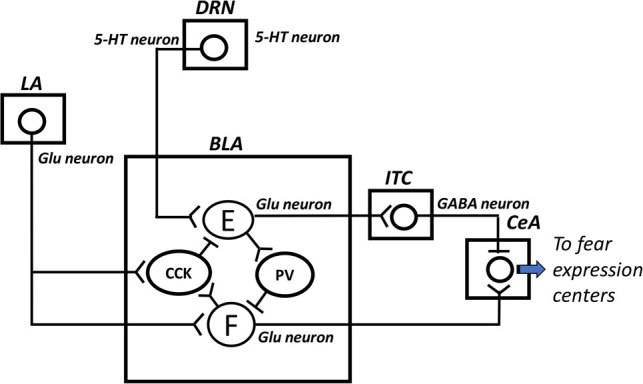Figure 2.

Interactions between serotonin (5-HT) and GABAergic systems in the basolateral amygdala (BLA) during fear expression and extinction. Following fear conditioning, presentation of the conditioned cue activates glutamatergic (Glu) neurons in the lateral amygdala (LA) that project to fear neurons (F) in the basolateral amygdala (BLA). The fear neurons activate, in turn, neurons in the central amygdala (CeA) for fear expression. The LA neurons also activate a BLA cell population that expresses cholecystokinin (CCK) and establishes GABAergic synapses with extinction neurons (E) within the BLA, inhibiting therefore these extinction neurons. Consequently, extinction neurons cannot inhibit fear expression through their Glu projections to BLA interneurons containing parvalbumin (PV), which establish a GABAergic connection with the fear neurons, or through their Glu projections to intercalated cells (ITC), which send GABAergic fibers to the CeA. It is well known that endocannabinoid signaling results in retrograde inhibition of afferent neurotransmission. Interestingly, the cannabinoid type 1 receptors are located presynaptically on CCK-containing cells. However, endocannabinoid synthesis is initiated via voltage-dependent mechanisms (Kano et al. 2009) and because of the inhibitory effect of CCK-containing cells on extinction neurons, endocannabinoids are not released. Here, it is hypothesized that, during extinction training, repeated presentations of the conditioned stimulus alone, indicating safety, may induce progressive enhancement of serotonin (5-HT) release in the BLA, which may partially activate the extinction neurons, hence provoking the release of endocannabinoids. The activation of the extinction neurons may be achieved with the inhibitory effect of endocannabinoids on CCK-containing cells via their cannabinoid type 1 receptors, resulting in inhibition of fear expression.
